On February 8, 2024, University of Wisconsin–Madison Chancellor Jennifer Mnookin addressed the Universities of Wisconsin Board of Regents. In a talk titled, “Innovation for the public good: A bedrock value and launchpad to the future, ” Mnookin shared her vision for building on the institution’s foundational excellence to lead in areas of affordability, innovation, and research. In her remarks, Mnookin announced the creation of a Sustainability Research Hub and the formation of the Wisconsin RISE Initiative that will take on grand challenges facing Wisconsin and the world, beginning with a new initiative on artificial intelligence.
The full text of her speech, as prepared, is below. The full set of slides from Chancellor Mnookin’s presentation are available for download, and a recording of her presentation is available on YouTube.
Good afternoon. I am delighted to welcome you all to UW–Madison on this beautiful day. It’s wonderful to be here with you. This has been — as you know — a year of a great many challenges, so I want to begin with a brief story of hope.
A couple of months ago, I had the privilege of sitting in on a fascinating and sometimes uncomfortable discussion right here in this room. Picture 120 students from different backgrounds, different majors, different places on the political spectrum, gathered in groups of 10, each with a trained faculty facilitator, eating dinner together and having a meaningful conversation about an important issue — in this case, the flat tax. In months to come, it’ll continue to be a range of topics, including quite polarizing issues like abortion and gun rights.
This is a program we’re piloting this year called Deliberation Dinners designed by our Dean of the School of Education, Diana Hess. It’s not meant to change minds or help participants reach a consensus, but to give them skills to engage with each other productively and respectfully, even when they disagree. To engage across difference, which needs to be a key part of the university experience.
The night I sat in, there was plenty of disagreement. The students were raising hard questions about how to define fairness, and what strangers owe one another, and debating different ways of contributing to the greater good. At the end, I saw students who had vehemently disagreed with one another walk out of this room together, chatting about the best places to study for finals.
I don’t yet know whether this pilot program will turn into something bigger. But I do know that we need better ways to help our students connect across their differences as we navigate the really challenging times we are living in, where what is happening on a global, national, and state level will certainly continue to affect us.
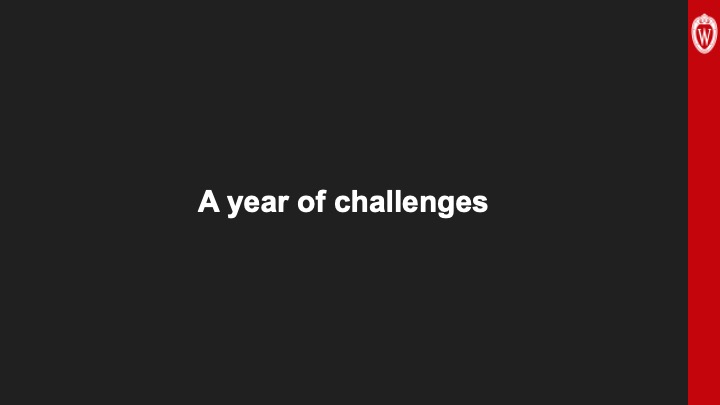 Globally, the brutal attack by Hamas on Israeli civilians and the ongoing devastating war in Gaza continue to have a grave and complex impact on our faculty, staff, students, and alumni. We’ve seen a deeply concerning rise across this country in antisemitism and Islamophobia, which we unequivocally condemn. And here on our campus, I have heard from Jewish and Muslim students that they have felt, at times, unseen and unheard, or judged or stereotyped based on their identities.
Globally, the brutal attack by Hamas on Israeli civilians and the ongoing devastating war in Gaza continue to have a grave and complex impact on our faculty, staff, students, and alumni. We’ve seen a deeply concerning rise across this country in antisemitism and Islamophobia, which we unequivocally condemn. And here on our campus, I have heard from Jewish and Muslim students that they have felt, at times, unseen and unheard, or judged or stereotyped based on their identities.
At the same time, we’ve been fortunate compared to a great many other schools where these issues have caused a deeper and uglier divide, which is not to say we haven’t dealt with some major challenges here, too. And these have sometimes been made more complex by divisive politics nationally as well.
One of the things all of higher education will need to reckon with is the intersection between the First Amendment and Title VI, which protects students’ right to an educational experience free of severe and pervasive forms of discrimination and harassment. These important values can come into tension with one another, and indeed, the Department of Education has opened an investigation at more than 100 campuses across the country, including ours, to find out more about how they have been handling these issues.
And here in Wisconsin, we’re navigating state politics in challenging times, and I want to acknowledge that this has not been easy and express my appreciation to all of you for your thoughtful approaches.
I also want to be clear that diversity of all kinds is a core value for us, and we cannot and will not stop our work in this realm. Full stop. At the same time, we can and should take a fresh look at what we want to accomplish, and assess what we’ve achieved over years of investment, and where there might be space, or the need, to try something different.
I believe that within the agreement we have reached with the legislature, we can stay true to the values that sustain us and continue to build inclusive excellence. So that, no matter your background, identity, experience, beliefs, or perspective, you can feel that you belong at the University of Wisconsin–Madison.
These issues will challenge us. And we will rise to meet those challenges in many different ways, including with programs like the Deliberation Dinners, programs built around the Wisconsin Idea tradition of innovation for the public good that’s allowed us to make the world a better place for 175 years.
 So let me give you a brief tour of some of the spaces where we’re currently excellent and the spaces where we are going to try some new innovative things to bring us into a future that’s even brighter than our storied past.
So let me give you a brief tour of some of the spaces where we’re currently excellent and the spaces where we are going to try some new innovative things to bring us into a future that’s even brighter than our storied past.
To begin, it’s been a year of excellence in education. There’s a national narrative that students enroll in college, rack up a lot of debt, and then don’t graduate. That’s sure not true here!
 Our four-year graduation rate rose to 75.5%, highest ever. Our six-year graduation rate rose to just over 89%, the highest ever. We’re one of top 10 public universities in the U.S. in this category. And as some of you heard this morning, our student-athlete graduation success rate also hit a record high this year (93% graduate w/in six years)!
Our four-year graduation rate rose to 75.5%, highest ever. Our six-year graduation rate rose to just over 89%, the highest ever. We’re one of top 10 public universities in the U.S. in this category. And as some of you heard this morning, our student-athlete graduation success rate also hit a record high this year (93% graduate w/in six years)!
The average time-to-degree for a bachelor’s degree recipients decreased to 3.84 calendar years, shortest ever. The university conferred a record number of total degrees, 12,407, topping 12,000 for the first time in our history. And 65% — nearly two thirds — of our undergraduates graduated with no student debt last year.
And you’ve heard me say before that a world-class university needs diversity of all kinds. When people of diverse identities, experiences, backgrounds, and beliefs work together, they not only learn from one another, but also drive creativity and innovation, and come up with better solutions to problems.
So I am happy to share that the current class of freshman and new transfer students is the most racially diverse in our history. And the freshman class includes Wisconsin students from tiny rural counties and big urban centers — 71 of the 72 counties are represented (missing Iron) … and students from 49 of the 50 states (missing Maine) … and 60 countries around the world.
This is the kaleidoscopic fabric that makes us great!
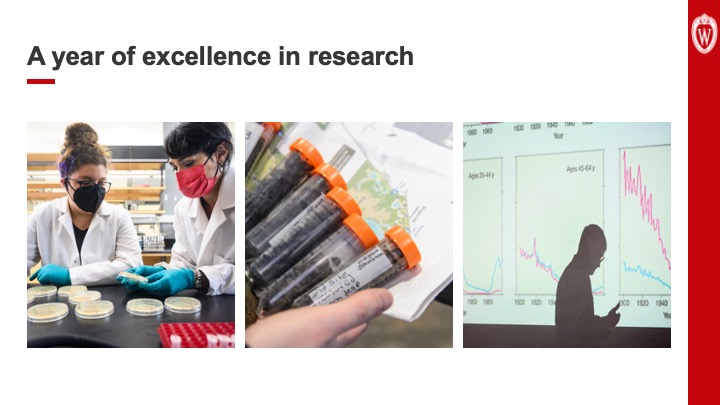 It’s also been a fantastic year for research at UW–Madison. We brought in more research dollars last year than in any other year in our history. Big increases can be driven by just one remarkable grant, but that’s not the case here. More than 15 departments and institutes had major increases — from Space Science & Engineering to Plant Pathology to the Population Health Institute.
It’s also been a fantastic year for research at UW–Madison. We brought in more research dollars last year than in any other year in our history. Big increases can be driven by just one remarkable grant, but that’s not the case here. More than 15 departments and institutes had major increases — from Space Science & Engineering to Plant Pathology to the Population Health Institute.
Part of this results from getting more strategic — better aligning ourselves with federal funding priorities. Our research related to aging is a great example. The over-65 population in the U.S. grew faster over the past 10 years than at any time since the late 1800s. We positioned ourselves years ago to become a leader in this arena by building big, interdisciplinary research centers with the right mix of expertise to innovate across disciplines. And some of our biggest leaps in grant funding this year were for our longitudinal studies and work around Alzheimer’s prevention. You might have seen the news just weeks ago about our new $150M grant to lead a national study out of the School of Medicine and Public Health to expand understanding of the full range of problems in the brain that can cause dementia and bring us closer to better treatments. This is the largest NIH grant we have ever received!
We’re now asking: What are the other fields where we can position the university for major discovery and innovation? I’ll tell you about our plans in just a moment. First I want to show you a few numbers.
 We maintained our spot as the number-eight-largest research institution in the country — but there’s a bigger story here.
We maintained our spot as the number-eight-largest research institution in the country — but there’s a bigger story here.
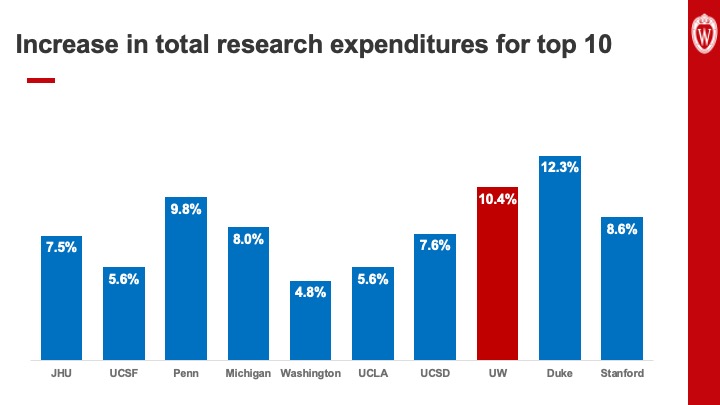 In the past year, we grew faster than anyone else in the top 10 except Duke. And our five-year average growth rate is second only to Johns Hopkins. If you look at the three institutions above us, we gained on all of them. The gap between us and UCSD is now just $10 million. In 2021, we were also just behind UCSD — but we trailed them by $45 million.
In the past year, we grew faster than anyone else in the top 10 except Duke. And our five-year average growth rate is second only to Johns Hopkins. If you look at the three institutions above us, we gained on all of them. The gap between us and UCSD is now just $10 million. In 2021, we were also just behind UCSD — but we trailed them by $45 million.
We have a couple of strategies to power us forward that I’ll tell you about shortly. And I want to say clearly: Not all first-rate research is grant-funded research. We have many ways that we engage and do work here. So we need to remember that this is an important frame for some — but certainly not all — of what we are aiming to do in our research space.
 And a word about our state’s new designation as a regional Technology & Innovation Hub for biohealth and personalized medicine, which you’ll hear about at tomorrow morning’s panel discussion.
And a word about our state’s new designation as a regional Technology & Innovation Hub for biohealth and personalized medicine, which you’ll hear about at tomorrow morning’s panel discussion.
This was an opportunity for partners across the state to work together in a next-level way, and it paid off. There were 400 regions across the country competing for this federal designation, and only 31 were selected. Partnership was essential to receiving the designation, but without a doubt, our powerhouse research enterprise played a crucial role in tipping the scales in favor of Wisconsin. We’re now competing for significant funding that will go to probably fewer than 10 of the 31 hubs. We hope to know more by summer, so stay tuned!
One necessary ingredient for bringing in major grants and growing our research is a modern physical infrastructure. This year we made progress on some key facilities.
 Babcock Hall and our Center for Dairy Research — our doctors on call to Wisconsin’s dairy industry — had not been updated in any significant way since Harry Truman was president (1951). As of last spring, we have the largest state-of-the-art dairy research facility in the nation! It’s already transforming innovation in research and education, not to mention our work with partners from one of the state’s most important industries.
Babcock Hall and our Center for Dairy Research — our doctors on call to Wisconsin’s dairy industry — had not been updated in any significant way since Harry Truman was president (1951). As of last spring, we have the largest state-of-the-art dairy research facility in the nation! It’s already transforming innovation in research and education, not to mention our work with partners from one of the state’s most important industries.
The long-awaited expansion of the School of Veterinary Medicine is close to completion. The first two floors housing surgery, critical care, imaging and a number of labs are opening this spring, which will transform our ability to provide care for animals large and small.
And it’s been so exciting to see the School of Computer, Data & Information Sciences take shape. It’s really coming together (though not quite this fast!) It will be the anchor for our high-tech corridor that’s going to link computing to biomedical research to engineering to medicine. It’ll bring together partners from all over campus and beyond to ignite discovery and innovation to help power Wisconsin’s growing tech sector.
And just as importantly, it’ll be the campus home for our largest major (Computer Science) and our fastest-growing major (Data Science) and a place that welcomes all students from all majors to expand their learning in these critical areas. The ability to synthesize analyze, and translate large, complex sets of data spans nearly all of the disciplines on our campus.
 And with the help of the Regents, the state legislature, Gov. Evers, and the biggest, broadest coalition of business and industry partners we’ve ever assembled, I’m hopeful that we are finally on our way to replacing an engineering facility that was last renovated nearly 40 years ago.
And with the help of the Regents, the state legislature, Gov. Evers, and the biggest, broadest coalition of business and industry partners we’ve ever assembled, I’m hopeful that we are finally on our way to replacing an engineering facility that was last renovated nearly 40 years ago.
As you know, this facility was the UW System’s number-one priority. It will be jointly funded by us and the state. Donors have already indicated interest in funding $110 million, and our already energetic fundraising has now kicked into even higher gear. This building will allow us to create a total of about 1,000 new spaces for undergraduates in engineering at a time when Wisconsin employers urgently need more engineers. We’re sending far too many talented Wisconsin students to Illinois and Purdue! It’ll be a beacon for top scholars from around the world who will drive the kinds of discoveries and innovations that will allow us to take on grand challenges. And it will expand our ability to work with industry partners.
 We have some exciting things taking shape with partners from industry all across campus. In November, for example, we announced a new 10-year collaboration between our School of Medicine and Public Health and GE Healthcare.
We have some exciting things taking shape with partners from industry all across campus. In November, for example, we announced a new 10-year collaboration between our School of Medicine and Public Health and GE Healthcare.
I want to thank the Regents for approving this agreement. It builds on work we’ve been doing together for the past decade, with a new focus on developing the next frontier of technologies for diagnosing and treating diseases like cancer in ever more personalized and precise ways. Our long partnership with GE Healthcare has now fueled more than 130 research projects! It’s a great example of the ways in which industry investment that aligns with our mission can drive discovery and help us change lives.
So building these partnerships is a substantial priority. We’re No. 8 in total research expenditures, but No. 46 in industry investment in R&D — and that’s up from 52 last year. Perhaps 46th is more impressive when you know it’s out of 900 institutions — but still we can do better. And we’re on the right track!
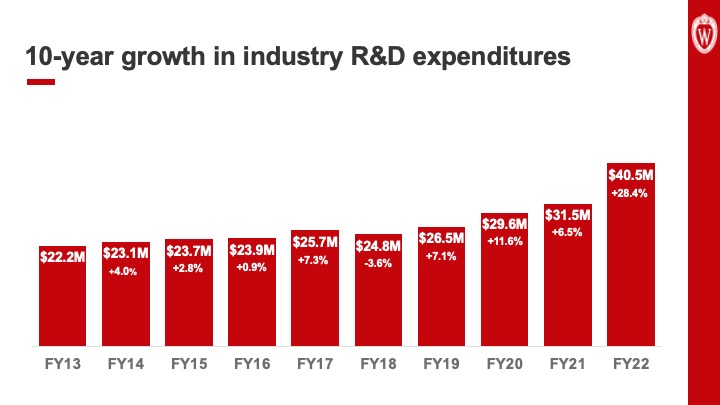 If you look at growth in dollars alone ($8.9M), our increase puts us in 7th place among the top 10. But if you look at percentage growth, we grew by 28%, faster than any other school in the top 10!
If you look at growth in dollars alone ($8.9M), our increase puts us in 7th place among the top 10. But if you look at percentage growth, we grew by 28%, faster than any other school in the top 10!
 And this isn’t just one great year — we’ve outpaced our competitors in the top 10 since 2018. It’s important to note that our industry engagements go well beyond research and well beyond Wisconsin’s major employers. University expertise is helping to build thriving businesses and vibrant downtowns all over the state — that’s the Wisconsin Idea!
And this isn’t just one great year — we’ve outpaced our competitors in the top 10 since 2018. It’s important to note that our industry engagements go well beyond research and well beyond Wisconsin’s major employers. University expertise is helping to build thriving businesses and vibrant downtowns all over the state — that’s the Wisconsin Idea!
And one of our greatest statewide ambassadors is the Division of Extension.
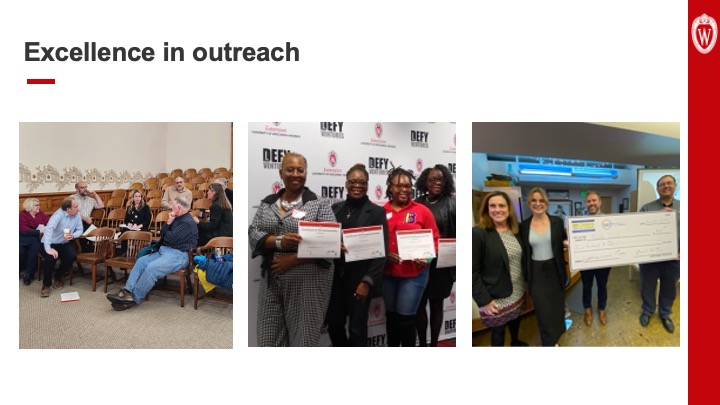 I spent a half-day with a group of Extension employees in November and learned about the incredible range of the work they’re doing in all of Wisconsin’s 72 counties. For example, they recently held facilitated conversations in 32 counties across the state to bring people from different sides of the political spectrum together to talk about hot-button issues. Afterward, participants reported viewing one another as less hypocritical and less selfish than had been their stereotype. And they’re nourishing entrepreneurship in rural areas as well as our cities to create the kinds of opportunities that help people and communities to flourish.
I spent a half-day with a group of Extension employees in November and learned about the incredible range of the work they’re doing in all of Wisconsin’s 72 counties. For example, they recently held facilitated conversations in 32 counties across the state to bring people from different sides of the political spectrum together to talk about hot-button issues. Afterward, participants reported viewing one another as less hypocritical and less selfish than had been their stereotype. And they’re nourishing entrepreneurship in rural areas as well as our cities to create the kinds of opportunities that help people and communities to flourish.
These are just two of the great many projects they do. They’re having a truly significant impact! But they’re so deeply woven into the fabric of the state that people often don’t realize that Extension is UW–Madison. So I have challenged them to do an even better job of sharing the outstanding impact of their work and to sharing that they’re a part of us.
 We have a lot to be proud of. My job — our job — is to make this institution even a step stronger by building on our existing excellence and also by thinking in big, bold ways about where we can take a quantum leap forward to serve this state and the world.
We have a lot to be proud of. My job — our job — is to make this institution even a step stronger by building on our existing excellence and also by thinking in big, bold ways about where we can take a quantum leap forward to serve this state and the world.
 Let me tell you about a few of the things in store this year.
Let me tell you about a few of the things in store this year.
First — we’re putting together an outstanding new class. We just received final numbers for applicants for the next freshman class and we’ve continued our 15-year record-setting streak!
Nearly 66,000 students applied for a spot in our freshman class — an increase of 3.7% over last year. Students and families are continuing to recognize that exciting things are happening here at UW–Madison!

 We have two initiatives we’ve launched to improve access and remove barriers for talented Wisconsin students with high financial need. A year ago in this space, I announced one of those programs, Bucky’s Pell Pathway, for Wisconsin students who qualify for the federal Pell grant. It’s a last-dollar-in scholarship program that sits on top of the Pell grant and other scholarships. And it covers the full cost of attendance (tuition, room and board, fees, books) for talented UW–Madison students from Wisconsin families who have great need.
We have two initiatives we’ve launched to improve access and remove barriers for talented Wisconsin students with high financial need. A year ago in this space, I announced one of those programs, Bucky’s Pell Pathway, for Wisconsin students who qualify for the federal Pell grant. It’s a last-dollar-in scholarship program that sits on top of the Pell grant and other scholarships. And it covers the full cost of attendance (tuition, room and board, fees, books) for talented UW–Madison students from Wisconsin families who have great need.
 I am delighted to tell you that in its first year, BPP is serving 977 students from 65 Wisconsin counties! Our BPP students are truly outstanding— let me introduce you to just one of them. This is Mattie Place. She’s a freshman from Platteville who plans to major in Business.
I am delighted to tell you that in its first year, BPP is serving 977 students from 65 Wisconsin counties! Our BPP students are truly outstanding— let me introduce you to just one of them. This is Mattie Place. She’s a freshman from Platteville who plans to major in Business.
She was class president for all four years of high school … played the flute in band … and participated in numerous student clubs, all while earning outstanding grades in a rigorous curriculum. In other words — she is exactly the kind of student who belongs at the state’s flagship! But her family’s finances haven’t always been stable. So, when she got word that she’d qualified for Bucky’s Pell Pathway, she told us she was completely shocked. She relayed the excitement of sharing the news with her mom, and the relief she felt knowing she could come here and just focus on being a student without constant worry about bills. That’s the impact of this great program!
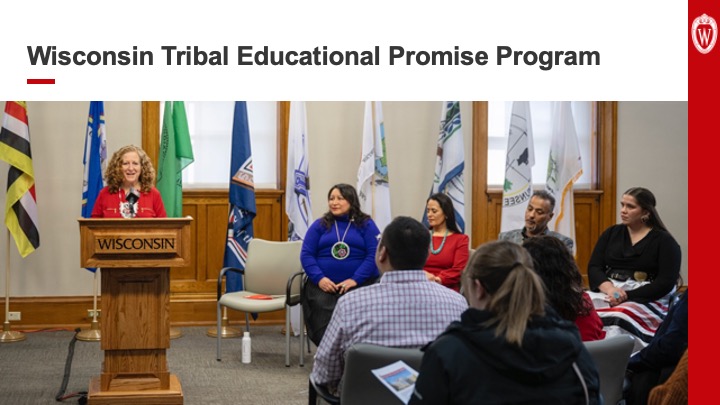 The second program we designed in partnership with tribal leaders — you might have seen coverage when we announced it in December. It will cover the full cost of a UW–Madison undergraduate degree for state residents who are members of federally recognized Indian tribes in Wisconsin. For incoming students and current students. And we’ll run a five-year pilot program to cover in-state tuition and fees for enrolled members of tribes in Wisconsin to pursue J.D. and M.D. degrees, given the pressing need for these professions in the Native communities.
The second program we designed in partnership with tribal leaders — you might have seen coverage when we announced it in December. It will cover the full cost of a UW–Madison undergraduate degree for state residents who are members of federally recognized Indian tribes in Wisconsin. For incoming students and current students. And we’ll run a five-year pilot program to cover in-state tuition and fees for enrolled members of tribes in Wisconsin to pursue J.D. and M.D. degrees, given the pressing need for these professions in the Native communities.
Want to thank the tribal leaders who worked in partnership with us to design this program. And one important note: Both Bucky’s Pell Pathway and the Wisconsin Educational Tribal Promise Program are funded fully by the university, without any state tax dollars.
 Of course, building educational excellence takes more than recruiting outstanding students and helping them graduate on time. It takes an outstanding experience in the classroom.
Of course, building educational excellence takes more than recruiting outstanding students and helping them graduate on time. It takes an outstanding experience in the classroom.
You heard this morning about how we’re using AI in education, and how many of our students have transformative experiences in research. But I love that our instructors are always looking also for small things that can make a big difference to improve learning.
 This is Prof. Briana Burton. The climbing wall picture is something she shows her students at the start of the semester, to explain her role as an educator. One of the classes she teaches is about 60 students from a wide variety of majors. It covers — among other topics —how different bacteria organize their DNA.
This is Prof. Briana Burton. The climbing wall picture is something she shows her students at the start of the semester, to explain her role as an educator. One of the classes she teaches is about 60 students from a wide variety of majors. It covers — among other topics —how different bacteria organize their DNA.
But the process she teaches is so new that there were no textbook images. She was using what you see on the left — pulled from a research article — which required the students to try to visualize a three-dimensional process that was brand new to them. Many found that really hard to do. So the media team at our Center for Teaching, Learning, and Mentoring worked with her to bring the image to life. Here’s what the students see now.
She compared test results from two different classes, before and after, and found that 57% in the hard-copy group demonstrated that they understood the concept compared to 80% in the animation group. You hear more about the bigger, splashier changes we’re making in education, but these small hinges can open big doors!
 Moving on to research. Maintaining and advancing discovery on this campus is going to require us to work collectively and strategically to build strength for the future.
Moving on to research. Maintaining and advancing discovery on this campus is going to require us to work collectively and strategically to build strength for the future.
And now, I’m pleased to share with you three ways that we’re doing just that. One to nourish and advance entrepreneurship to help bring more UW–Madison research and innovations out of our labs and classrooms and into the world. One to greatly expand our work in, and commitment to, sustainability, which includes creating a new sustainability research hub. And one to catalyze our excellence to address some of the world’s grand challenges.
The first is still in its early stages. Our goal is to take our already thriving hub of innovation and entrepreneurial excellence and make it even stronger.
 I’ve appointed this mighty all-star team to take a look at How we can knit together the many programs that already exist on and around this campus to make them easier to tap into, and where we have opportunities to do something new and different to support the many faculty, staff, and students who are interested in entrepreneurship and commercialization.
I’ve appointed this mighty all-star team to take a look at How we can knit together the many programs that already exist on and around this campus to make them easier to tap into, and where we have opportunities to do something new and different to support the many faculty, staff, and students who are interested in entrepreneurship and commercialization.
There are more than 400 companies all over Wisconsin that have their origin stories here at UW–Madison. Industry leaders like Epic and SHINE, small start-ups founded by our students — like Fetch Rewards and EatStreet — and many more, including more than 25 companies founded by faculty and students in our Department of Medical Physics!
Our UW–Madison entrepreneurs are changing lives and communities, creating jobs, and contributing hundreds of millions of dollars to the state’s economy. At the same time, our students are pursuing entrepreneurship education like never before. We’ve had 700% growth in enrollment in these classes over the last 15 years!
And this state has emerged as a national powerhouse in high growth areas like the life sciences thanks to the entrepreneurial ecosystems we’ve built here.
It’s clear to me that this is an area where we have opportunities to really magnify our economic impact on Wisconsin and to shepherd life-changing innovations out into the world.
The working group is engaging broadly right now and will bring recommendations to me later this spring, so stay tuned.
 Second, I’m excited to announce that we’re launching a major cross-campus initiative around environmental sustainability focused on advancing not only our research but also education and making UW–Madison a living laboratory for sustainable practices.
Second, I’m excited to announce that we’re launching a major cross-campus initiative around environmental sustainability focused on advancing not only our research but also education and making UW–Madison a living laboratory for sustainable practices.
This is a space where we’ve been pioneers in many ways — from ecology and wildlife biology, to land restoration, to the use of satellite technology to detect changes in the environment. We have an impressive list of accomplishments, but these alone don’t qualify us to be a world leader in sustainability.
What does qualify us to lead is the particular way in which we engage with the work. Which is, quite simply, to start with looking at real-world, concrete problems. Leaning into the pragmatism that is so naturally ‘UW’.
Many of our accomplishments in this space have begun not in a university lab but in the community — wading into trout streams with people who fish, walking the Northwoods with hunters, visiting dairy farms, talking with urban farmers in Milwaukee. The very essence of the Wisconsin Idea! The community engagement drives and shapes the cutting-edge environmental research and scholarship.
This is what we owe to our neighbors and to Wisconsin — as settlers on Native land, as beneficiaries of public funds, and as educators preparing our students to make a real difference in the world.
So I am very excited to announce this initiative, and I want to thank the Nelson Institute and the Office of Sustainability, along with the ASM Student Advisory Council on Sustainability for their leadership.
 You can see the goals on this slide. They’re also in your handouts. I won’t take the time to go through all of these, but a few comments on a couple of them:
You can see the goals on this slide. They’re also in your handouts. I won’t take the time to go through all of these, but a few comments on a couple of them:
First, addressing the environmental impact of our campus, which is both imperative and an outstanding opportunity to do some innovative things in education. We’re setting clear, defined campus wide targets for the first time, and that’s essential on a campus the size of a city when you can only succeed if everyone’s working together. Like our environmental research, this initiative will be very community focused — what happens on our campus affects our neighbors!
For example, when we moved from coal power to gas power, Dane County’s air quality improved. Our students are brimming with ideas for making our campus a living laboratory; they’ve already inspired a number of initiatives now underway, from solar panels to ways of reducing food waste. I’m really excited to see how we weave this work more intentionally into the curriculum.
Second —the Sustainability Research Hub. This will be a center of excellence intentionally designed to build on our long tradition of working across. At other universities, these hubs are often embedded in one school or one college. Not so with ours. I am fully funding it initially out of my office to jump-start it and ensure that every researcher in every discipline on this campus has the resources and the opportunity to engage in sustainability research if they wish. We want to break down barriers and tear down siloes!
 The final project is our quantum leap, and I’m thrilled to be announcing it today. I want to introduce you to the Wisconsin RISE Initiative. Rise stands for Research, Innovation, and Scholarly Excellence.
The final project is our quantum leap, and I’m thrilled to be announcing it today. I want to introduce you to the Wisconsin RISE Initiative. Rise stands for Research, Innovation, and Scholarly Excellence.
We’re going to look at the grand challenges facing our state and the world and grow our faculty in a targeted way that builds on our existing strengths, in places where, with strategy and investment, we can accelerate discovery and world-changing research and education, innovate for the public good and be absolutely best in class.
Because here at UW–Madison, we want to RISE to meet the biggest research challenges of our time.
Over the last months, Provost Isbell and I have been in discussions with the deans and others to arrive at three key goals. First, to recruit top scholars from multiple disciplines at all stages of their careers to bring interdisciplinary perspectives to the many different facets of deeply complex problems. Second, to focus in meaningful part on areas with the potential to attract significant external research funding, as well as philanthropy, to further drive discovery and get us closer to any number of moonshots. And third, to create exciting new educational opportunities for students at all levels.
As this initiative progresses, there will be several foci and each will be interdisciplinary and involve a number of schools and colleges.
We have just defined the first RISE area — Artificial Intelligence — which capitalizes on our strengths in data science and computer science while pulling in social sciences, humanities and human ecology to put people at the center of our solutions.
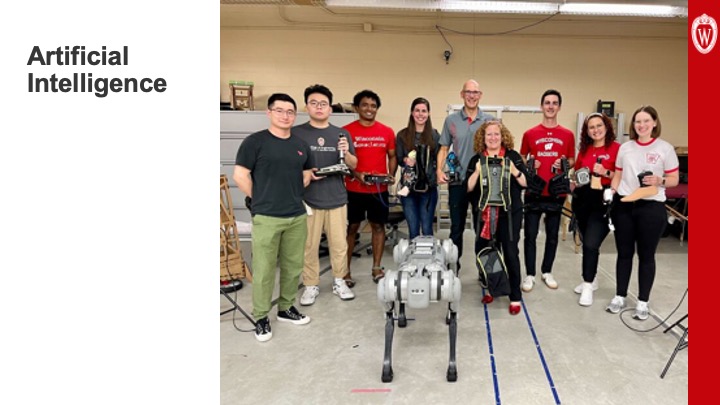 AI and machine learning are already enhancing human abilities in every one of our disciplines — they’re extraordinarily powerful and essential tools that allows us to sift through enormous quantities of data to find patterns and trends that guide decision-making and help us solve problems.
AI and machine learning are already enhancing human abilities in every one of our disciplines — they’re extraordinarily powerful and essential tools that allows us to sift through enormous quantities of data to find patterns and trends that guide decision-making and help us solve problems.
 And our past discoveries and innovations in AI are a launchpad to a dazzling future. For example, Professor Miron Livny, whom you all know, pioneered high-throughput computing techniques that are now powering some of the world’s largest scientific experiments, including the search for cosmic neutrinos and black holes. Today, that work is part of what positions us to move forward in some exciting new directions.
And our past discoveries and innovations in AI are a launchpad to a dazzling future. For example, Professor Miron Livny, whom you all know, pioneered high-throughput computing techniques that are now powering some of the world’s largest scientific experiments, including the search for cosmic neutrinos and black holes. Today, that work is part of what positions us to move forward in some exciting new directions.
Again, to give just one example, Juan Caicedo is an investigator at the Morgridge Institute who’s now applying Professor Livny’s techniques to biological imaging, which could turbocharge our understanding of cell biology and help us discover new drugs.
 And this is just one area. Our faculty, staff, and students are using AI in all sorts of exciting ways. For example, the College of Agricultural and Life Sciences is using it to help farmers predict crop yields and detect disease before it spreads. The Center for Healthy Minds is exploring how to develop personalized ‘micro-supports’ delivered through our mobile devices. For example, to engage a student in a breathing exercise just before an exam. And just last week, one of our undergraduate entrepreneurs who’s built his own small consulting gig around the ethical use of AI led a workshop for faculty and staff in our School of Journalism and Mass Communication titled, “AI as your teaching copilot.”
And this is just one area. Our faculty, staff, and students are using AI in all sorts of exciting ways. For example, the College of Agricultural and Life Sciences is using it to help farmers predict crop yields and detect disease before it spreads. The Center for Healthy Minds is exploring how to develop personalized ‘micro-supports’ delivered through our mobile devices. For example, to engage a student in a breathing exercise just before an exam. And just last week, one of our undergraduate entrepreneurs who’s built his own small consulting gig around the ethical use of AI led a workshop for faculty and staff in our School of Journalism and Mass Communication titled, “AI as your teaching copilot.”
There are tremendous possibilities — and tremendous concerns. AI needs expert human guidance and ethical guardrails, and we are also on the leading edge of scholarship to ensure the ethical, responsible, and trustworthy use of AI.
AI has genuinely transformative potential, with high stakes, great possibilities and significant risks. We also already have a good number of talented faculty in a variety of relevant disciplines working in this space, so we have a very strong foundation on which to build. So, AI was really a natural choice to be the first focus area for our Wisconsin RISE initiative.
We’ll begin hiring as soon as this spring, in phases, with the ultimate goal of hiring up to 50 new faculty into this first initiative in AI. We are fortunate that our growth in enrollment and research gives us the opportunity to grow our faculty, and the necessity to do so.
Wisconsin RISE will open up not just research opportunities but also some exciting new pathways in education, at both the undergraduate and graduate levels. It is simply a fact that every student in every major is going to need to have at least some familiarity and facility with AI.
And investing in this way will give us a virtuous cycle where the university is positioned to compete for research funding (federal and private) on a new level, which we invest in more discovery and innovation, which in turn attracts great faculty, who in turn attract great students.
This AI initiative is the first RISE initiative, but it will be the first of several. We are also rolling out a process that will continue to invite the faculty, staff, and campus leaders to work across disciplines to advance further bold ideas that can change the world.
The deans are helping to spearhead a process to bring the strongest of those ideas to the provost and myself for additional consideration.
I am so excited to see how Wisconsin RISE can help ignite creativity and transform our ability to take on the most pressing challenges of our time. And I want to thank the provost, and the deans, and the considerable number of faculty who already have been deeply involved in putting this together.
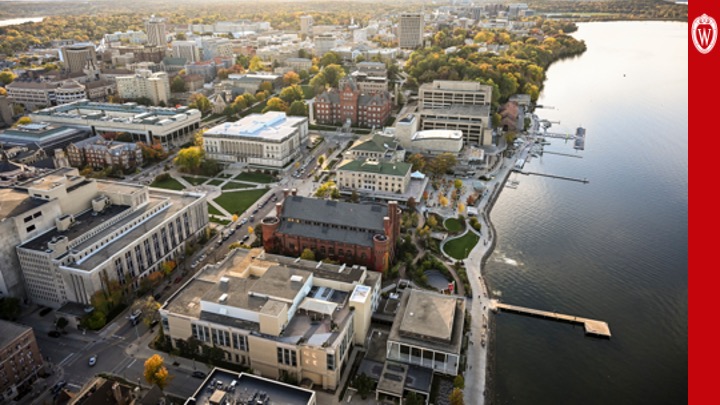 So let me conclude with this: I am bullish on this amazing university, and I hope you are too!
So let me conclude with this: I am bullish on this amazing university, and I hope you are too!
This is an incredible institution, and even in challenging times, there is an extraordinary amount to be proud of. We are proud of what we are accomplishing at Madison, and we are proud to be part of the Universities of Wisconsin, committed to providing transformative opportunities to students all over our great state.
We’re meeting the moment — as we have for 175 years — with integrity and discipline and a spirit of cooperation. It’s all thanks to our incredible community of partners including our phenomenally talented faculty, staff, and students; the most loyal and dedicated alumni and donors anywhere; our collaborators across industry and communities — including our partners at the other Universities of Wisconsin campuses and in the UW administration; and all of you, members of the Board of Regents, who provide the leadership to support and guide our work.
These are the ingredients for a truly dazzling future that I look forward to all of us building together!

